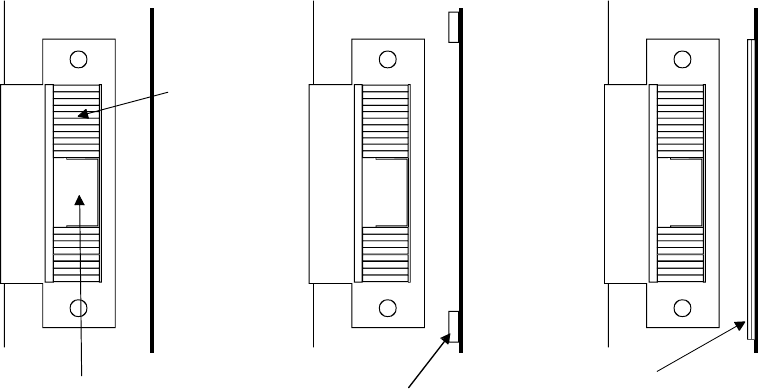
Rev. A.1, 8/01 Page- 5
If the amount of slack or rattling is less than 1/16-1/8”, you have a “tight” door and the ability
of the door to close and latch reliably is in question. To adjust for this, first check to see if the
stop has “silencers” on it. These are cylindrical rubber bumpers which quiet the noise of a
closing door but also have the effect of making the door close earlier. Remove the silencers
(they pull out) and this will add slack to the closed position of the door. Be sure to check the
entire length of the door for the silencers. If the door has no silencers and is still tight in
latching, a locksmith should be engaged to readjust the door so that it closes properly or the
installation will not be reliable.
Figure 4 illustrates the points made in this Section.
FIG. 4: FINAL ADJUSTMENT OF DOOR CLOSING TOLERANCE
VIEW OF MORTISE UNLATCH LOOKING STRAIGHT INTO DOOR FRAME
SPRINGLATCH PLUNGER
DEADLATCH
FINGERS
SILENCER
TWO SPACERS
3. OPERATION
While you can make a successful installation without knowing how the Mortise UnLatch
functions, it’s best if you understand its operation in the event you run into difficulties or
questions. The operation of the Mortise UnLatch is, of course, intimately connected with the
way mortise locks work on a door so we’ll cover this first.
Mortise locks are the highest quality and heaviest duty locks for sale in North America. They not
only provide long operating life but deliver the highest level of physical security obtainable in a
mechanical latch. To assure this security, all mortise locks include deadlatching function. This
means that when the door is closed and latched, a deadlatch pin, present on the lock face, is
pressed in. This mechanically pins the springlatch so that it cannot be moved by an object
(such as a credit card) which is pushed in between the door and frame.
In order to release the mortise latch, the Mortise UnLatch has two moving elements under the
control of a motor. We call these the springlatch plunger and deadlatch fingers. When the
door is in the closed and secure position, the springlatch pushes in the springlatch plunger and
the deadlatch pin rests on the deadlatch fingers which push in the deadlatch pin. This maintains
the latch in the secure position and makes full use of the deadlatching function.
When the Mortise UnLatch operates (the trigger wire connects to the +V wire), the deadlatch
fingers retract into the body of the Mortise UnLatch which allows the deadlatch pin to move out.
Then the springlatch plunger and deadlatch fingers simultaneously push the latch and deadlatch
pin back into the lock body and the door may be opened from the outside. This operation takes
about 1/3 of a second. When the trigger wire is removed from the +V wire, the Mortise UnLatch
will return to its initial condition: the springlatch plunger will retract into the Mortise UnLatch body
which allows the latch to resecure the door and the deadlatch fingers will push out depressing
the deadlatch pin and freezing the latch for best security.













